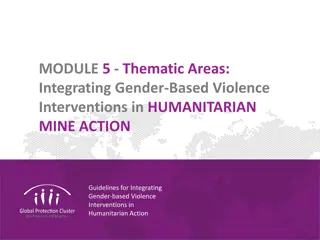Innovative Approach to Active Leprosy Case Finding at Dusk in Dadra & Nagar Haveli
The prevalence rate of leprosy in Dadra & Nagar Haveli has been a concern, with high disability rates observed. Data analysis reveals a higher female proportion among new cases compared to the national average. Despite no scientific basis for gender susceptibility, the region shows unique patterns. An intervention involving active case finding was implemented during evening hours with a modified survey timing strategy.
Download Presentation

Please find below an Image/Link to download the presentation.
The content on the website is provided AS IS for your information and personal use only. It may not be sold, licensed, or shared on other websites without obtaining consent from the author. Download presentation by click this link. If you encounter any issues during the download, it is possible that the publisher has removed the file from their server.
E N D
Presentation Transcript
Action at Dusk Active Case Finding For Leprosy in Evening Hours Best Practices under NLEP in Dadra & Nagar Haveli
Background The Prevalence Rate (PR) of Leprosy in the UT of Dadra & Nagar Haveli has been highest in the country continuously for many years India as a country achieved elimination stage for Leprosy in 2005 by decreasing PR <1.0 but even after that the PR in DNH kept on increasing In DNH - PR was 6.77 in March 2016 against All India PR of 0.66 per 10000 population Grade II Disability in cases at diagnosis was 20.6 per million population in 2016-17 in DNH whereas it was 3.94 at India level Data Analysis in 2016 showed more Grade II Disability in Males although females outnumbered significantly in total no. of cases (In contrast to National scenario)
INDIA PR ANCDR 12 10.66 10 9.83 9.63 8.18 8 7.77 7.3 6.77 6.7 6.6 D&NH PR ANCDR 6 6 5.67 4.99 4.95 4.7 4.52 4 4.04 3.82 3.63 2.93 2.5 2.49 2.28 2.2 2.11 2 1.88 1.7 0 2005 2006 2007 2008 2009 2010 2011 2012 2013 2014 2015 2016 2017
Observation/Analysis of Data in UT UT of Dadra & Nagar Haveli had higher female proportion among new Leprosy cases continuously from 2009 2015 in comparison to the national level Female proportion of New Leprosy Cases comparison
Rationale Males and Females both are equally susceptible to Leprosy provided all other factors are similar There is no scientific basis which can explain that females are more prone to get affected by Leprosy The national level data on new Leprosy cases indicate significant continuous male dominance The national data from 2012 -2018 showed an average of 39% females and 61% males among new cases This was in contrast to what has been observed in D&NH (approx. 58% females and 42% males)
Rationale continued... Female proportion among new Leprosy cases in Dadra & Nagar Haveli more but the analysis showed More Grade II Disability among the males
Intervention/Methodology Active Case Finding Survey timing was modified (from the erstwhile 9:00 am 5:00pm) to 9:00am to 01:00 pm in the first half and 5:00 pm to 8:00 pm in the second half During the first half, the team comprising of one male & one female visited the houses to screen households The houses with unavailable males/females are noted and their probable time of availability is recorded The male volunteer/MPW revisits those houses in evening hours after 5 pm to screen the missing males/females The female worker/ASHA accompanies the team till 6 pm only to screen females missed during first half The objective of this modified timing was to cover the majority of males and some working females who are not available at home during day time
Human Resource (Existing and /or New) No new human resource is required The innovative approach only modified the timing for selective screening as per local needs The same search team member/health staff deployed to screen the persons missed during day time
Evidence of Effectiveness This innovative approach was started for the first time in May 2016 The proportion of males increased from 45% (in ACF surveys prior to 2016) to 56% That indicated the presence of hidden male cases in the community. This conclusion was further reinforced by the fact that 62.5% of G2D cases at diagnosis were males
Evidence of Effectiveness In the year 2016 -17, the female proportion of new cases decreased from 57.89% in 2015-16 to 51.50%)
Results/Outcome of Innovative approach The gap between males and females in new cases reduced In the year 2019-20, equal number of males and females were diagnosed as Leprosy (Graph - 2) Graph 2 : Proportion of males & females among new Leprosy cases in DNH 70 58.1 60 58.5 58 58 56 56 55 52 51.5 52.4 50 50 50 48.5 47.6 48 45 40 44 44 42 42 41.5 41.9 30 20 Female% Male % 10 0 2009-10 2010-11 2011-12 2012-13 2013-142014 -15 2015-16 2016-17 2017-18 2018-19 2019-20
Results/Outcome The perceptible benefits of this approach are The proportion of males in cases confirmed out of suspects identified between 5-8 pm was 33/45 (73.33%), indicating our objective was met. The female proportion among new cases got balanced and approaching to 50% which is a desired level. The number of G2D which was predominantly in males, got drastically reduced and reached Zero (Graph 3).
Cost Effectiveness No direct additional cost was incurred The novel approach just modified the timing for Active Case Finding Surveys The only thing needed to materialize this approach was motivation of field staff for survey in evening hours The benefits due to this are significant and perceivable
Key Challenges: Motivating the field staff for working beyond 6:00 PM is not easy It becomes much difficult in rainy season to continue the activity after sunset Scalability: The approach adopted in the UT of D&NH is easily replicable and applied to anywhere else in the country Although the approach of suitable timing can be equally adopted for screening of other communicable as well as non- communicable diseases
Conclusion The higher proportion of G2D among males in contrast to more females among new cases was indicative of hidden male cases as well as delay in diagnosis in males Also, the proportion of males in MB cases was high A simple but difficult to implement innovative approach neutralized the female predominance among new cases of Leprosy in the UT to a great extent Those missing 5- 7% of male cases contributed to G2D in the long run When the incidence bias was neutralized, the G2D decreased rapidly and the UT became G2D free with no new case of G2D since March 2018. A simple approach contributed to a significant decrease in PR (from 6.77 in March 2017 to 2.7 in March 2020) and G2D from 20.1 in 2016-17 to Zero in 2018-19 per million populations.
Way Forward The UT of D&NH is continuing this approach for ACF for Leprosy since 2016 and will continue it Now the approach is also being used for ACF for Tuberculosis
THANK YOU COMMITMENT TO ERADICATE LEPROSY SHS-NLEP CHANDIGARH























